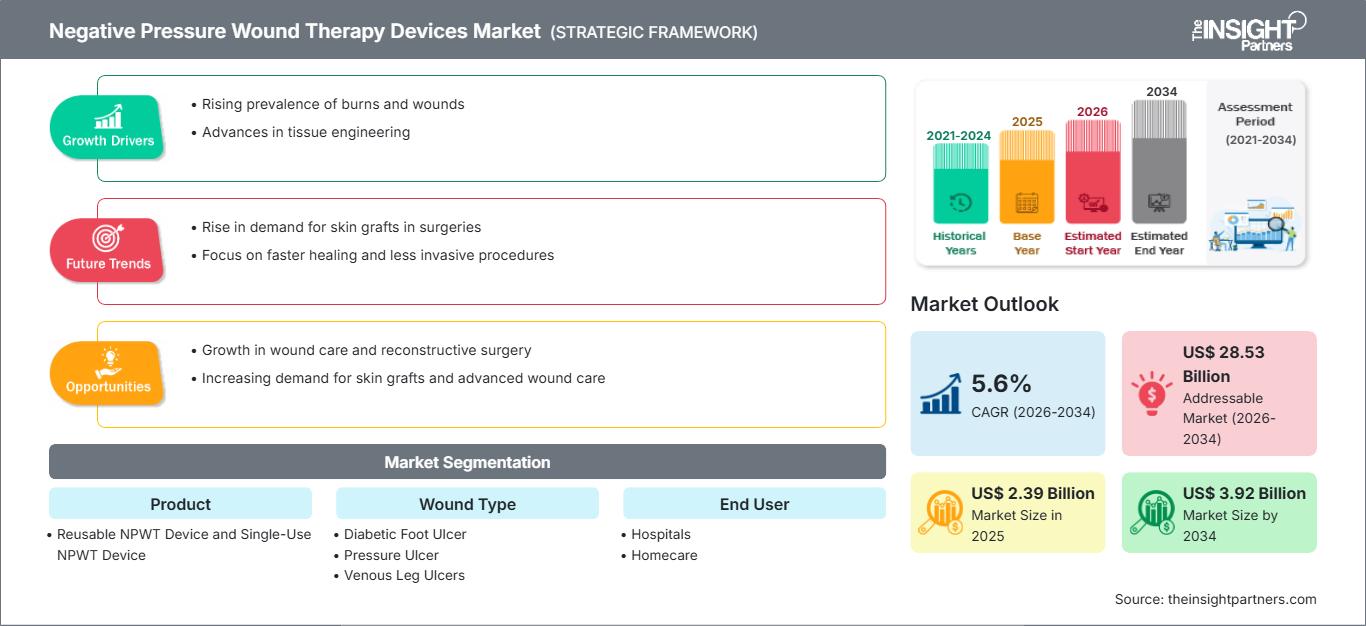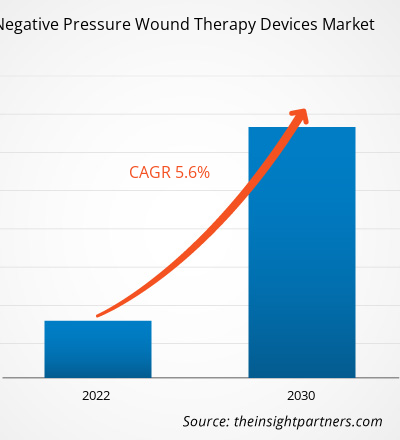Se proyecta que el mercado de dispositivos de terapia de heridas con presión negativa, valorado en 2390 millones de dólares estadounidenses en 2025, alcance los 3920 millones de dólares estadounidenses para 2034, con una tasa de crecimiento anual compuesta (TCAC) del 5,6 % entre 2026 y 2034. Las condiciones del mercado siguen evolucionando, lo que genera nuevas oportunidades para las partes interesadas. El panorama general refleja un progreso estable y un potencial de crecimiento a largo plazo.
El uso de dispositivos de NPWT simplificados de un solo uso ha aumentado significativamente. Este desarrollo reconoce las ventajas de contar con NPWT listos para usar y a un menor costo. Abarca dispositivos eléctricos y mecánicos. Los dispositivos de un solo uso son ampliamente preferidos para reducir complicaciones como la dehiscencia o la infección al aplicarse sobre incisiones quirúrgicas cerradas. En comparación con los planes originales para los dispositivos cuando se introdujeron por primera vez en las clínicas, las indicaciones sobre qué tipos de heridas pueden tratarse con NPWT ya se han ampliado gracias a los avances tecnológicos en el campo. Por ejemplo, nuevos tipos de heridas (pequeñas heridas quirúrgicas) ahora pueden tratarse en nuevos entornos (como la atención domiciliaria a corto plazo) gracias a la disponibilidad de bombas desechables más pequeñas y de un solo uso. Además, las nuevas intervenciones en curso mencionadas anteriormente podrían aumentar potencialmente la mayor asimilación.
Factores impulsores del crecimiento:
Las políticas de reembolso favorables impulsan el crecimiento del mercado de dispositivos de terapia de presión negativa para heridas.
Una ventaja del reembolso por dispositivos para la terapia de heridas con presión negativa (TPN) es que facilita el acceso al cuidado avanzado de heridas. Este tratamiento exitoso para pacientes con heridas complejas se fomenta cuando los profesionales de la salud reciben el reembolso por los dispositivos de TPN. El uso de dispositivos de TPN puede prevenir complicaciones relacionadas con heridas crónicas, lo que resulta en mejores resultados para los pacientes, una cicatrización más rápida y, posiblemente, menores costos generales de atención médica. El reembolso incentiva a los centros de salud a adquirir e implementar estas tecnologías, lo cual beneficia tanto a los pacientes como al sistema de salud.
CPT |
|
|
97605 |
Terapia de heridas con presión negativa (p. ej., recolección de drenaje asistido por vacío), utilizando equipo médico duradero (DME), que incluye aplicaciones tópicas, evaluación de la herida e instrucciones para el cuidado continuo, por sesión; área total de la superficie de la herida menor o igual a 50 centímetros cuadrados |
|
97606 |
Terapia de heridas con presión negativa (p. ej., recolección de drenaje asistido por vacío), utilizando equipo médico duradero (DME), que incluye aplicaciones tópicas, evaluación de la herida e instrucciones para el cuidado continuo, por sesión; área total de la superficie de la herida mayor a 50 centímetros cuadrados |
|
97607 |
Terapia de heridas con presión negativa (p. ej., recolección de drenaje asistido por vacío), utilizando equipo médico desechable y no duradero que incluye la provisión de un sistema de recolección para el manejo de exudados, aplicaciones tópicas, evaluación de la herida, Página 6 de 7 Medicare MP192 e instrucciones para el cuidado continuo, por sesión; área total de la superficie de la herida menor o igual a 50 centímetros cuadrados |
|
97608 |
Terapia de heridas con presión negativa (p. ej., recolección de drenaje asistido por vacío), utilizando equipo médico desechable y no duradero, incluido el suministro de un sistema de recolección para el manejo de exudados, aplicaciones tópicas, evaluación de la herida e instrucciones para el cuidado continuo, por sesión; área total de la superficie de la herida mayor a 50 centímetros cuadrados |
HCPCS |
|
|
A6550 |
El kit de cuidado de heridas para bomba eléctrica de terapia de heridas con presión negativa incluye todos los suministros y accesorios. |
|
A7000 |
Recipiente desechable para usar con bomba de succión, cada uno |
|
A9270 |
Artículo o servicio no cubierto |
|
A9272 |
Succión de heridas, desechable, incluye apósito, todos los accesorios y componentes, cualquier tipo, cada uno |
|
E2402 |
Bomba eléctrica para terapia de heridas con presión negativa, estacionaria o portátil |
Fuente: Cardinal Health
Por lo tanto, las políticas de reembolso favorables impulsan el crecimiento del mercado de dispositivos de terapia de heridas con presión negativa.
Personalice este informe según sus necesidades
Obtendrá personalización en cualquier informe, sin cargo, incluidas partes de este informe o análisis a nivel de país, paquete de datos de Excel, así como también grandes ofertas y descuentos para empresas emergentes y universidades.
Mercado de dispositivos de terapia de heridas con presión negativa: Perspectivas estratégicas

-
Obtenga las principales tendencias clave del mercado de este informe.Esta muestra GRATUITA incluirá análisis de datos, desde tendencias del mercado hasta estimaciones y pronósticos.
Segmentación y alcance del informe:
El “análisis del mercado de dispositivos de terapia de heridas con presión negativa” se ha llevado a cabo considerando el producto, el tipo de herida y los segmentos de usuario final.
Análisis segmentario:
Por producto, el mercado de dispositivos de terapia de heridas con presión negativa se divide en dispositivos NPWT reutilizables y dispositivos NPWT de un solo uso. El segmento de dispositivos NPWT reutilizables tuvo una mayor participación de mercado en 2022 y se prevé que registre una tasa de crecimiento anual compuesta (TCAC) del 5,8 % durante el período de pronóstico.
Los dispositivos reutilizables son más económicos ya que eliminan la necesidad de comprar constantemente artículos de un solo uso, lo que a su vez impulsa el crecimiento del segmento.
El mercado de dispositivos de terapia de heridas con presión negativa, por tipo de herida, se segmenta en úlceras del pie diabético, úlceras por presión, úlceras venosas de pierna y otras. El segmento de úlceras por presión tuvo la mayor participación de mercado en 2022 y se prevé que registre la tasa de crecimiento anual compuesta (TCAC) más alta, del 6,0 % durante el período de pronóstico.
El mercado de dispositivos de terapia de heridas con presión negativa, por usuario final, se clasifica en hospitales, atención domiciliaria y otros. El segmento hospitalario tuvo la mayor participación de mercado en 2022 y se prevé que registre la tasa de crecimiento anual compuesta (TCAC) más alta, del 5,9 % durante el período de pronóstico.
Análisis regional:
El informe del mercado global de dispositivos de terapia de heridas con presión negativa incluye la evaluación del desempeño del mercado en América del Norte, Europa, Asia Pacífico, América del Sur y Central, y Oriente Medio y África. En 2022, América del Norte ostentaba la mayor cuota de mercado en este sector. El envejecimiento de la población en Canadá aumenta la incidencia de heridas crónicas, lo que impulsa la demanda de productos de vanguardia para el cuidado de heridas, como los dispositivos NPWT. Existe una creciente necesidad de tratamientos eficientes para el manejo de heridas debido a la creciente prevalencia de enfermedades crónicas, como la diabetes y la obesidad, que incrementan el riesgo de desarrollar heridas crónicas. El mercado canadiense de dispositivos NPWT es dinámico y está en expansión debido a estos factores.
Oportunidades futuras:
En los países en desarrollo se reporta con frecuencia una alta prevalencia de heridas crónicas debido a factores como el aumento de la incidencia de enfermedades contagiosas y una infraestructura sanitaria inadecuada. Las necesidades médicas insatisfechas pueden abordarse con dispositivos de NPWT, ya que ofrecen soluciones avanzadas para el cuidado de heridas. Según un artículo publicado en la Sociedad Internacional de Farmacoeconomía e Investigación de Resultados (ISPOR), el 15 % de los diabéticos en la India experimentan úlceras del pie diabético (UPD) en algún momento de su vida. Por lo tanto, es probable que la creciente demanda de dispositivos de NPWT en las economías en desarrollo genere amplias oportunidades para el mercado de dispositivos de terapia de heridas con presión negativa durante el período de pronóstico.
Dispositivos de terapia de presión negativa para heridas
Perspectivas regionales del mercado de dispositivos de terapia de heridas con presión negativa
Los analistas de The Insight Partners han explicado detalladamente las tendencias y los factores regionales que influyen en el mercado de dispositivos de terapia de heridas por presión negativa durante el período de pronóstico. Esta sección también analiza los segmentos y la geografía del mercado de dispositivos de terapia de heridas por presión negativa en América del Norte, Europa, Asia Pacífico, Oriente Medio y África, y América del Sur y Central.
Alcance del informe de mercado sobre dispositivos de terapia de heridas con presión negativa
| Atributo del informe | Detalles |
|---|---|
| Tamaño del mercado en 2025 | US$ 2.39 mil millones |
| Tamaño del mercado en 2034 | 3.92 mil millones de dólares estadounidenses |
| CAGR global (2026-2034) | 5,6% |
| Datos históricos | 2021-2024 |
| Período de pronóstico | 2026-2034 |
| Segmentos cubiertos |
Por producto
|
| Regiones y países cubiertos |
América del norte
|
| Líderes del mercado y perfiles de empresas clave |
|
Densidad de actores del mercado de dispositivos de terapia de heridas con presión negativa: comprensión de su impacto en la dinámica empresarial
El mercado de dispositivos de terapia de heridas con presión negativa está creciendo rápidamente, impulsado por la creciente demanda del usuario final debido a factores como la evolución de las preferencias del consumidor, los avances tecnológicos y un mayor conocimiento de los beneficios del producto. A medida que aumenta la demanda, las empresas amplían su oferta, innovan para satisfacer las necesidades del consumidor y aprovechan las tendencias emergentes, lo que impulsa aún más el crecimiento del mercado.

- Obtenga una descripción general de los principales actores del mercado de dispositivos de terapia de heridas con presión negativa
Panorama competitivo y empresas clave:
El pronóstico del mercado de dispositivos de terapia de heridas con presión negativa puede ayudar a las partes interesadas en este mercado a planificar sus estrategias de crecimiento. 3M; Smith+Nephew; DeRoyal Industries, Inc.; Nexa Medical Limited; Lion Street Medical, LLC (Pensar Medical LLC); ConvaTec Inc.; Cardinal Health, Inc.; Mölnlycke Health Care AB; PAUL HARTMANN; y Medela AG se encuentran entre las empresas destacadas que se describen en el informe del mercado de dispositivos de terapia de heridas con presión negativa. Estas empresas se centran en el desarrollo de nuevas tecnologías, la modernización de los productos existentes y la expansión geográfica para satisfacer la creciente demanda de los consumidores a nivel mundial.
- Análisis histórico (2 años), año base, pronóstico (7 años) con CAGR
- Análisis PEST y FODA
- Tamaño del mercado, valor/volumen: global, regional y nacional
- Industria y panorama competitivo
- Conjunto de datos de Excel
Informes recientes
Informes relacionados
Testimonios
Razón para comprar
- Toma de decisiones informada
- Comprensión de la dinámica del mercado
- Análisis competitivo
- Información sobre clientes
- Pronósticos del mercado
- Mitigación de riesgos
- Planificación estratégica
- Justificación de la inversión
- Identificación de mercados emergentes
- Mejora de las estrategias de marketing
- Impulso de la eficiencia operativa
- Alineación con las tendencias regulatorias






















 Obtenga una muestra gratuita para - Mercado de dispositivos de terapia de heridas con presión negativa
Obtenga una muestra gratuita para - Mercado de dispositivos de terapia de heridas con presión negativa